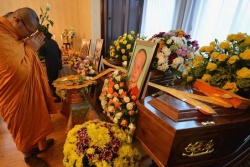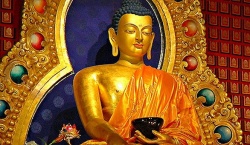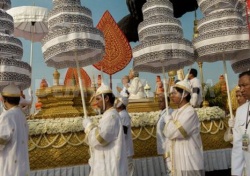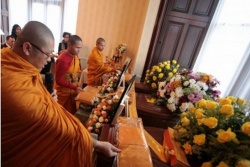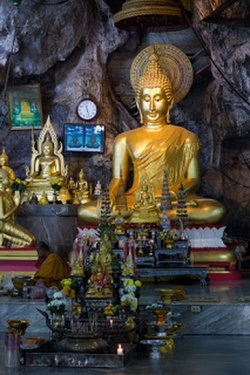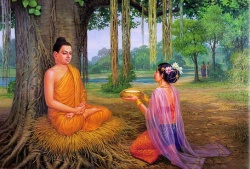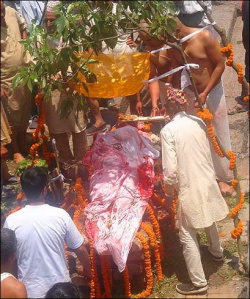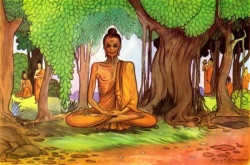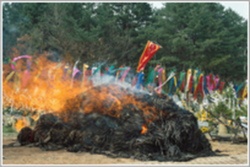Funeral Rites of the Hindus and the Buddhists
As morbid as it sounds, but that life ends in death is inevitable; the question is how do we cope with such a loss?
By the way, a few days ago I came across a rather morbid web site called deathclock.com. The screen is done in dark colors and interspersed with silhouette of a church and tombstones. In the center it provides an input box where, if you want, you can type in your birth date and your gender (a bare minimum of information for such a vital calculation). You then click the OK button to see "your personal date of death" ticking away in seconds. The website sells these clocks, but I wonder who would buy them and for what purpose. I liked its logo, however, that says "… friendly reminder that life is slipping away... second by second."
My own experience with the loss of a loved one came when my sister died after a prolonged illness. Although I was 8 years old at the time of her death, I still remember the various events that followed her death. My sister was married, hence Nepali social customs relegated her widower to be responsible for funeral ceremonies.
Nepal (and in general most of the Southeast Asian countries) is a male-dominated society, and this trend reflects in funeral customs as well. For instance, if a husband dies leaving a widow behind, the person leading the funeral charge would be his eldest son. If the eldest son is unavailable for any reason, his next son will take over the duties. If deceased male has no son, the funeral responsibilities goes to his father even though the departed soul may have living daughters.
Funeral rituals in Nepal are steeped in religious tradition, with Hindu priests and Buddhist Lamas providing spiritual guidance to the dead on its ultimate journey to the eternal world. Elaborate rituals are needed to propitiate gods and deities so that the soul may be given unhindered passage to its next destination. Sometimes, especially in Buddhist funeral ceremony, the soul itself needs to be convinced that it no longer belongs to this mortal world, and that it now needs to get prepared to travel to the ethereal world. All these arcane and complex funeral ceremonies are performed with a single aim: to ensure that the departed soul doesn't get stranded in the netherworld for lack of proper guidance on way to heavenly destiny.
Immediately after my sister's death, Lama priests were notified. Soon the priests and their lay helpers began to file into the house bringing with them their ceremonial accoutrements. It was the beginning of a three-day vigil over the dead body in repose. This vigil is very important for the Buddhists who believe that upon death the soul leaves the earthly body immediately but hovers around it for three days and that sometimes within this timeframe the soul may decide to reunite with the body causing an instance of miraculous resurrection. And so, in such an ambiance of bereavement and eternal hope the Lamas and the family began their vigil, somewhat akin to the Christian wake.
For three days the priests chanted religious texts in unison, rang bells and beat drums and blew tuba-like instruments at various interval. They burned many oil lamps and incense in front of the makeshift Buddha image constructed next to the dead body. All family members were required to be present at certain times of the day for prayer services. All friends and neighbors were welcome to burn oil lamps, provide offerings, watch the ceremony, or pray with the Lamas any time.
Emotionally and financially, funeral is quite a taxing time for the family. The Lamas and their entourage must be housed and provided for. All required ceremonial supplies must be purchased, and where needed, leather-less shoes must be purchased for the male members of the family, for they are prohibited from wearing leather shoes for a year. Also all household members are required to refrain from eating salt for the three days. This prohibition comes off at the end of the third day when the Lamas distribute a specially anointed salt to the family. But on the positive side, such a somber ceremony conducted by robed Lamas with the exclusive purpose of conciliating the departed soul of the beloved family member surely acts as a soothing balm.
The Hindus, on the other hand, believe in the hastened departure of soul. They believe that once it sheds the body, the soul prepares to depart immediately on its karmic journey, and as such, it's very important to cremate the body as soon as practicable so as not to provide any allurement for the soul to linger on to this side of the world. Therefore, Hindu customs require the body to be taken to the holy grounds and cremated as soon as all the family members have had a chance to view it.
It could very well be that climate may have played some role in determining the duration of the wake. The Buddhists, inhabiting cooler mountainous regions, could afford longer wake period without the fear of putrefaction, whereas the Hindus, occupying plainer, humid and hot regions, couldn't. This is just a conjecture, though. (Recently, I was talking to a Hindu friend of mine. He told me that now-a-days in most large cities in India a family can rent space in an air-conditioned mortuary should they need to keep the body longer for some faraway family members to arrive.)
Customarily, Buddhists bury their dead, but in Nepal and elsewhere, partly because of lack of burial grounds and partly because of Hindu influence, they cremate their dead and share the same burning ghat with the Hindus. The dictionary defines a burning ghat as "a level space at the head of a ghat for cremation." A ghat is defined as "a broad flight of steps that is situated on a riverbank and that provides access to the water especially for bathing." This is only partially true. A ghat is a riverbank with or without steps, which are man-made.
Hindu religion imposes certain criteria as to the ideality of death. For instance, death in a hospital or in a house is religiously undesirable. To assure quick salvation of the soul, the Hindus believe that one must seek to breath one's last lying on the bank of a sacred river (Hinduism considers any river a holy river) with a flurry of prayer emanating from his mouth. Growing up in Nepal, I have witnessed instances where a critically sick man, whose imminent death having been predicted by the attending priest, was hurriedly carried away from his home to a local riverbank for a death vigil. The irony was, just as death itself, the priest could only approximate - must less guarantee - the time of death. In some instances I have also witnessed situations where the predicted death didn't occur. Instead, the dying man got well enough to return to his home.
It is the ultimate wish of a Hindu to die and be cremated along a riverbank; the holier the river the better for the departed soul. Many Hindu holy shrines are built along famous riverbanks. Banaras, situated along the holy river Ganges, is the holiest of them all, considered so holy that every Hindu wishes to be anointed by the Ganges river's water at his death's door. Indeed, the desire to die on the bank of the Ganges river is so irrepressible that even today there are pious Hindus in India who make provisions to move to Baneras at an old age for the sole purpose of waiting to die on the bank.
At long last, my sister's three-day vigil ended. A long funeral procession of the chanting Lamas and male family members and friends accompanied my sister's body to the bank of river Baghmati. By prior arrangement, a pyre had already been built. As the Lamas read the last rites, the body was laid on the pyre. Then, as is customary, the first fire was lit by her husband, followed by other male family members, including myself. Soon fire consumed the woods and the cadaver, reducing both elements to a few ounces of ashes. The ashes were entrusted to the slow flowing river Baghmati to be carried away to the holy Ganges. The funeral rites having completed, the entire procession returned to my sister's home where a feast was prepared to say thank you and goodbye to the Lamas and their party as well as to all the family friends.
Once the feast is over and the guests depart one by one or en masse, and only when the core family members find themselves alone for the first time, does the real family mourning begin. It's also the time for the family to discuss the final funeral ceremony that must be held within a year.
The Hindus follow the same regiment in the disposal of the body. As the Brahmins chant funereal hymns, the living male member of the deceased family sets the first fire to the pyre. Unlike the Buddhists, who prefer immediate dispersal of the ashes over the river, the Hindus collect them in an urn for disposal in a special year-end ceremony. After cremation, family members return to their homes to begin an eleven-day mourning period during which the immediate family's diet get severely restricted. For instance, they're prohibited from eating salt, certain vegetables, and meat. They are also required to wear white-colored clothes only, and they must set aside anything made out of leather, such as watch band, belt, shoes, etc.
On the 10th day, the Hindu priests set up an elaborate ceremony where various gods and goddesses are invoked and worshipped in the name of the deceased, a great variety of foods are prepared and offered to the departed soul, and all family members participate in the worship and offering. On the 11th day, the priests perform the right of absolution freeing everyone from all the restrictions; henceforth, family members are free to return to their normal lives.
For the Buddhists, while the Lama priests set the family free of the dietary and sartorial restrictions at the end of the third day, it's time now to plan for the final funeral ceremony as early as can be arranged but certainly within a year. It's up to the family to decide the duration of such a ceremony that could last anywhere from a single day, abbreviated affair to a month long, elaborated one, or somewhere in-between.
In my sister's case, it was decided that the final ceremony would be of a 3-day duration. Once again, Lamas and their helpers were invited and provisions were made. While the family worked hard to accommodate the priestly party, the Lamas chanted passages from the voluminous religious books. Hundreds of oil lamps lighted the Buddha image and sweet fragrance from the burning incense wafted throughout the house. The periodic bell ringing and the rhythmic drum beating coalesced with the low-pitched sound of the tuba-like horn instruments to create an eerie ambiance, at least in the mind of an 8-year old.
The Lamas were chanting instructions to my sister's soul, providing it the proper road map for the eternal journey. The Buddhists believe such instructions are essential for the soul to make a successful journey to its final resting place. Sans such help, the soul will get caught in a limbo, which is a bad omen for the family.
According to Buddhist tradition, the last day of the ceremony is the day when the soul, until now still living in the house, departs on its journey to eternity with the guidance of the Lama priests. Because of its symbolic meaning, this day culminates in the saddest of the mourning days. All members of the family are required to attend this last ceremony.
My sister's final funeral day began with a light task for the Lamas. For the past few days they've been reading the scriptures from early morning to late dawn, but this morning they'd pray in silence and prepare a small paper flag with my sister's name written on it, and at mid-day they'd perform the final rites.
The final ceremony began as the priests placed the paper flag in the center of the 108 unlit oil lamps. Then they began to chant the last scriptural readings for a few hours. At the end of the reading all the family members were invited to light the oil lamps that surrounded the paper flag. Then the head Lama lifted the paper flag. As the ringing bells and beating drums reached a crescendo, he lighted the flag with the flame of the largest of the oil lamps. Family members wept and sobbed. The flag burned into ashes. This was the final goodbye. The soul has departed from this world.
The funeral ceremony, the Buddhists believe, guarantees eternal peace to the departed soul, while the final flag-burning as part of the ceremony, guarantees purification of the house by formally letting go of the spirit both emotionally and spiritually.
The Hindus, on the other hand, wait for a full year to complete their funeral rites. At the one-year anniversary, they offer foods and prayers to the dead through Brahmin priests and arrange for the disposal of the ashes. A single day is all that it takes for the priests to complete the prayer and offering, but the question of what to do with the ashes requires a balance between family wish and financial affordability. Ideally, ashes should be scattered in or around holy rivers and places. The Hindus consider the Himalayas as the holiest of all the places on earthr it has been the source of the holy Ganges and many other lesser known but no less holy rivers, as well as the abode of many gods and goddesses. The former Indian premier Indira Gandhi's ashes were scattered over the Himalayas. The majority, however, can't afford the expense of such a luxurious sendoff.
Those who can afford, travel to Baneras, or any other holy places in India, and scatter the ashes in the holy rivers. Those who can't afford, dispose of the ashes in a nearby local river.
